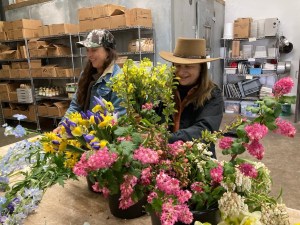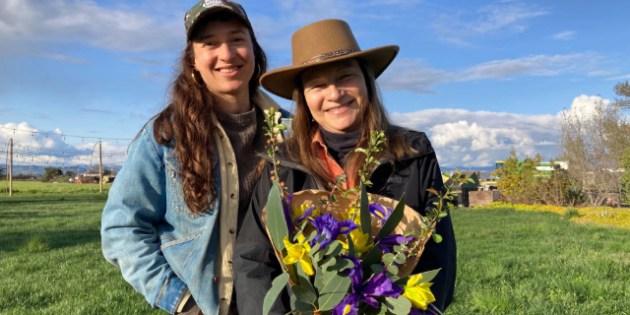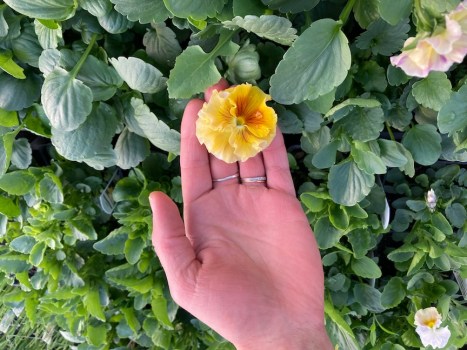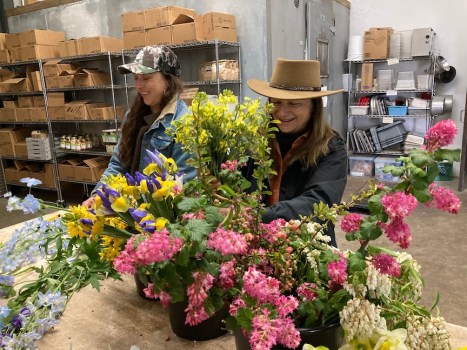Rogue Valley mom, daughter have a passion for flowers that goes back generations
Published 2:30 pm Friday, May 2, 2025
La Mera Gardens in northwest Medford wants to put more locally grown flowers into people’s hands
There are many ways to love flowers, even among family members. Joan Ewer Thorndike, an organic flower farmer and mom, carries delphiniums in her arms as she walks from one of her greenhouses into a warehouse at Le Mera Gardens in Northwest Medford.
She sets the tall stems with blue blossoms into a bucket of water, and smiles at her daughter Isabella Thorndike Church, who creates botanical installations through her company, Jacklily Seasonal Floral Design.
Joan then talks about her late mother, Lily, who pulled herself away from her home garden 10 minutes before she was to be at her office in the United Nations Building in Santiago, Chile.
Lily tended flowers to counter her stressful work on the Economic Commission for Latin America. Her apartment terrace had more plants than space to walk, and she couldn’t understand her daughter Joan’s Oregon business, one of the oldest organic, specialty cut commercial flower farms in the U.S.
How can you sell a flower, Lily would ask. How do you commercialize them, give them a monetary value? How do you part with them?
Joan, whose family’s passion for flowers reaches back generations, had a clear answer: Her goal is to put more locally grown flowers into people’s hands.
Flower popularity
Joan Thorndike grows her Le Mera Gardens flower crop on fields and in greenhouses at the Fry Family Farm. She sells wholesale to florists and event planners, and bulk flowers to do-it-yourself wedding parties, charity fundraising organizers and others through her online shop.
The seed for Le Mera Gardens started long before Joan married, moved to the Rogue Valley and had children, and long before her mother asked her how she could grow flowers to sell.
In the 1970s, while visiting the United States for the first time from her native Chile, Joan stopped to buy fresh flowers to bring to her dinner host. She handed the florist a $5 bill and received one stem of freesias. One stem?
At the time, buying flowers in the U.S. was typically a luxury reserved for a special occasion. It was many years before U-pick farms and growers markets made it easier to bring home locally grown blooms.
Today’s popularity of spontaneously picking up flowers, seeds and houseplants, most of which are imported and sold at chain stores, has increased total spending on floral products by 75% in 10 years, according to the Society of American Florists.
Locally grown flowers have their devoted fans. The National Garden Association’s 2024 survey found that almost 70% of the 2,500 people who were asked said they buy domestic flowers to keep local agriculture vibrant, small farms in business and jobs in their community.
“I grow flowers for others because I love our flowers,” said Joan, who started Le Mera Gardens in 1992 when her daughter Camila was 5 and Isabella was 3. “I want my village to share in the pleasure of living with flowers that are grown right here, grown in this soil and under this sun, that mirror the seasons.”

Multicolor pansies are a bedding plant that are being used in flower arrangement, said Joan Thorndike of Le Mera Gardens in the Rogue Valley. Janet Eastman photo
Science and art
One of the busiest holidays of the year for flowers is Mother’s Day, and Joan and Isabella think it’s no surprise the day to honor “a mother by birth or a mother by choice,” said Joan, is in spring when flowers are abundant. One ruffly, tricolor pansy, scented geranium or a sweet pea nosegay, given with love, Joan said, is enough to make a person swoon.
Some people, Joan and Isabella have found, don’t like cut flowers because of their impermanence, but this mother and daughter embrace flowers’ ephemeral quality. Like locally grown food or wine grapes, fresh flowers are an expression in the moment of a place and time. They evoke a feeling, a memory, and if given away, a message.
There are people, including Joan and Isabella, who appreciate the beauty of a flower along with the science and art of growing them. A keen interest in horticulture also runs in their family.
Joan’s uncle, the late botanist Noel Lothian, was director of the Adelaide Botanic Garden in Australia, and her great-grandfather, book publisher John Lothian, would have competitions among his grandchildren to grow the tallest sunflower. Her uncle Noel always won.
Joan uses eco-friendly farming practices, and her USDA certified-organic and Oregon Tilth Certified Organic Le Mera Gardens is Bee Friendly and Salmon Safe. Isabella only uses locally grown and consciously sourced materials for her art.
Joan’s husband, Dan Thorndike, is board president of the nonprofit Southern Oregon Land Conservancy, and their older daughter, Camila Thorndike, is well known for her work with Sen. Bernie Sanders and others toward a climate-safe future.
Turning to look at her youngest daughter, Joan describes a photo of Isabella at 5, looking serious while holding mismatched flowers and weeds she had gathered. “That’s when I realized the seed had been planted,” Joan said.
The photo is on Isabella’s fine art floral studio website, Jacklily, named after her maternal grandparents, Jack and Lily.
Isabella said Jack explored the glaciers, mountains and wild places of Chile, which, like Oregon, is a land of natural and agricultural abundance. And Lily purchased flowers at street corner stands and pruned stray branches and blooms during her daily walks.
At night, Lily took the flowers outside to breathe the city of Santiago’s cool night air, Isabella said.

Joan Thorndike gets help from daughter Isabella Thorndike Church to prepare a spring arrangement made with flowers, ornamental foliage and herbs grown at Le Mera Gardens in the Rogue Valley. Janet Eastman photo
A life filled with flowers
Joan listens as Isabella (whom she calls “Izzy” and at times “Bella” and “Bellita”) talks about riding in her car seat while Joan made flower deliveries. Paying attention to her surroundings has set Isabella apart as a floral artist.
Her large-scale botanical artwork and floral designs have been commissioned by the Oregon Center for the Arts’s Schneider Museum of Art in Ashland and galleries, restaurants, shops and single-day events in Oregon and Northern Vermont, where Isabella and her husband, Jeremiah Thorndike Church, live part of the year.
“Izzy has an affinity for shapes and finds glory in a branch on the ground, the form and tone of seedpods, and what she assembles is always a surprise,” said Joan.
In April, Joan was putting together fresh flowers for a baby shower and Isabella naturally started to help. They stepped gracefully through the greenhouses wearing knee-high farm boots. Showing the same smile, they leaned into flowers lined in tidy rows and knew exactly which ones to harvest.
Inside the farm warehouse, containers were filled with spring flowers: two-tone purple irises, gold and white double daffodils, white and purple daphne clusters, yellow forsythia and bell-shaped white Leucojum (summer snowflake).
Nearby were flowering ornamental herbs and foliage also grown on the farm: yellow kale blooms, blue-flowering rosemary, pink flowering quince, pendant pink currant flowers and silvery gray eucalyptus.
“The color of a flower is one thing,” said Joan, looking over her choices, “but what that color does to enhance the other flowers is the magic.”
Isabella only knows a life filled with flowers. “It’s the water I have always swum in,” she said.
Like a horticulturalist, she studies the intricate growth habit of a stem or branch, and as an artist, she allows the colorful, textured materials to take the lead; “showing my hands where and how it wants to be placed in the design with the least amount of resistance,” she said.
“My hope is that when people see my work, they may be drawn to an ingredient,” she continued, “and then be more likely to notice this ingredient out in the world.”
Recently, Isabella was in eastern Oregon and noted sage-green and orange-red rocks among like-colored sagebrush and budding willows. To her, it seemed “as if they had spoken to each other,“ she said.
”We don’t have to force beauty, it’s there,” she said, “and as a designer, my principle has always been in line with what’s in season; it’s truly the most beautiful.”
Authenticity is a good word to describe this mother and daughter’s approach to their work and life. Seeing a chrysanthemums or tasting a strawberry out of season is jarring, said Joan. “A strawberry in winter doesn’t taste right,” she said.
“It doesn’t taste like anything,” said Isabella.
“It robs the magic,” said Joan. “In our family, we make a wish on the first strawberry of the season, the first flower, the first anything. We are a very wishy family.”
Isabella said her grandmother Lily, who never drove a car, walked to work and took a bus to shop. It would have been efficient to buy all of her groceries in one place.
Instead, Lily spent hours on buses or on foot, traveling from one part of Santiago to the next, to buy the sweetest cherries in one market, the freshest fish in another, said Isabella.
“I respect, admire and have inherited her commitment to quality and respect for the ingredients of our daily lives, whether food or flowers,” said Isabella. “A meal is only as delicious, and a floral design only as beautiful, as its ingredients.”









